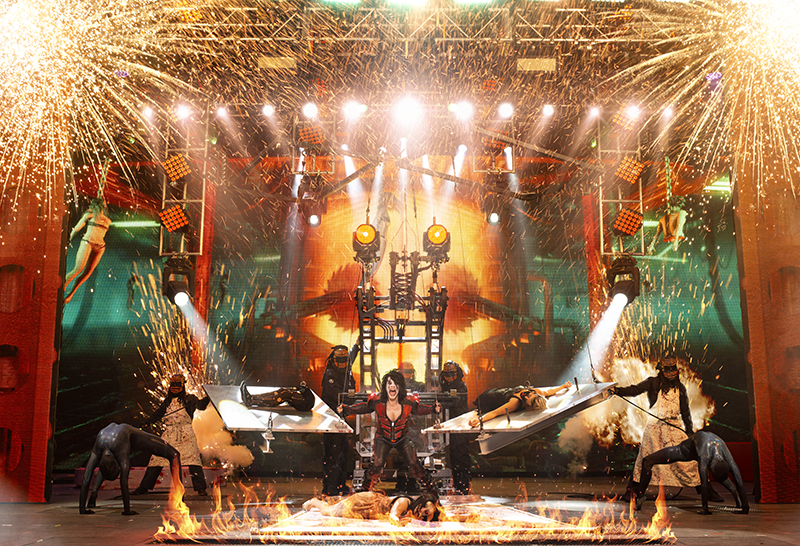
Criss Angel has been heralded as having the most amazing production of any magician — ever. Mindfreak, the new 90-minute spectacular at Planet Hollywood Resort & Casino Las Vegas is the most sophisticated, technologically-advanced theater show the world has ever seen, featuring more than 75 of Angel’s signature illusions, 20 of which are unseen up until now. His performances over the years have included just about every production element one could utilize to enhance a live performance. The difference in this show is that all the lighting, video and pyro effects are incorporated as part of each illusion, as opposed to just illuminating the production.
Angel closed a decade-long run at the Luxor on October 28, 2018 with barely six weeks until the opening of his new show at the renamed Criss Angel Theater — of his own design — at Planet Hollywood. After his lengthy relationship with Cirque and MGM at Luxor, Criss realized “I couldn’t creatively stay in that one room. For what I wanted to do, I would need to build my own space, from the ground up. So, when Planet Hollywood offered us a space that we could demolish and recreate to my own specs, we went for it.”
Angel felt that Vegas shows were stagnant. “I felt that the city’s productions had become complacent. Nobody’s pushing the envelope like they used to. In a town like Las Vegas that offers entertainment choices for everyone, I wanted to create a spectacle. I wanted to make a statement. Perhaps that’s why we have more lighting fixtures in this show than even pop artists touring arenas.” The sheer amount of video and pyro involved in Mindfreak is unmatched as well.
Last month Angel was awarded the GOAT Award by his peers, as the Greatest Magician of All Time. The reason this honor was bestowed on him is simple to understand once you’ve seen Mindfreak. There’s no sense in trying to guess what’s up Angel’s sleeve because you will never see it coming. Any of it. I watched for 90 minutes and was wowed for every single one of them. The opening number alone exhausts a huge number of visual spectacles that don’t merely accent each illusion, but cleverly lead you from one trick directly into the next. To say the audience was in sensory overload is an understatement. When Criss finally stopped to take a breath, you could almost hear the audience utter a sigh of relief — followed by thunderous applause.
Being the consummate showman, Angel knows when to take it down a notch to settle the crowd in for his next bit. He explains, “The show is not just about the high-speed thrilling parts. I take the audience to different levels. Over the course of my show I take them to the attic, to the club, we sit down in a living room. I take the audience on a trip over highs and lows with the crescendo being my brand-new levitation. I’ve been working on that for almost 20 years.” This is indeed a show that never stops evolving. It will not remain stagnant for the next five years of this residency, either.
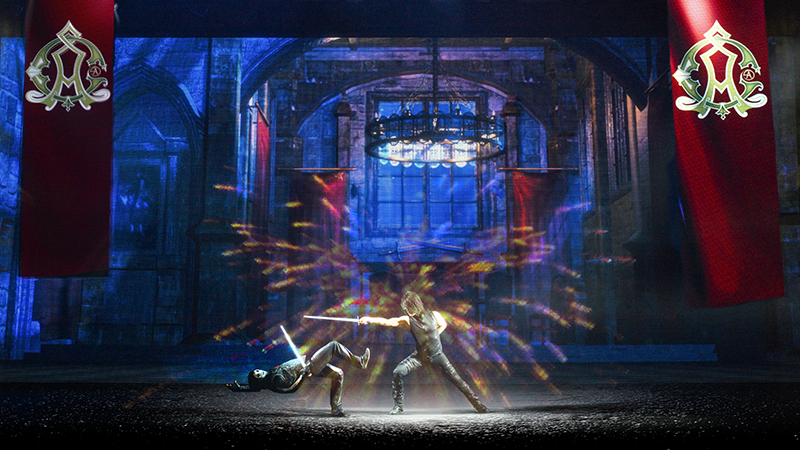
Building a ProductionCriss says, “I started working on this show nine months before we opened. I was able to do that because I own a 60,000 square foot facility here in town. For what I planned to do, I required a fully automated stage. So I designed and completely fabricated it in my studio. By having control of the whole room at Planet Hollywood I was able to do the seating layout and figure out where to put all the automation points for the tricks and props to fly in and out. The old stage in this room was made of concrete, if you can imagine that. We had to remove it, so I could move mine in.”
Criss is a huge proponent of using cutting-edge technology, claiming he’s been beta testing gear for years. He also knows his show technically. “We have over 2,000 lights in this show. We have over half a billion pixels of video across over 90 surfaces; 38,000 pounds of gear hanging over the audience alone. I have partners and vendors that I really trust now. But what really brought it all together was a guy who’s become my friend, my go to guy for just about everything, Mike from Blue Planet.”
“Blue Planet was such an important part of putting this production together, and they are second to none in continued support. As Mike can verify, I’m not afraid to call him after midnight to ask him to have someone bring us down some cables the next day. I tell you what, I’ve dealt with these big box companies all over town. They say they’ll call right back, but you don’t hear from them for days. I felt I needed a personal relationship with someone that can look after this show’s needs. My perishable costs alone on this show are ridiculous. Any product I can get through Mike and Blue Planet — I do.”
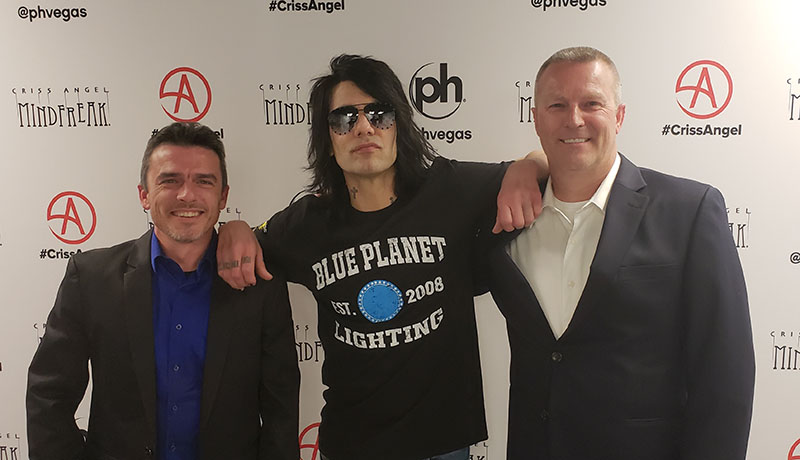
Blue Planet’s Role
Blue Planet consists of two guys originally from Missouri, Mike Gormley and Kelly Koster. They were both lighting designers who traveled quite frequently and figured out a way to get off the road. They set up shop in Branson, MO 11 years ago when it was a happening town full of theaters and tourists. They sold gear from theatrical expendables to lighting fixtures. One day the two friends were looking at their future and where they could do the most business. Logistics determined that place would be Vegas. So off they went, calling on the only friends they had in the area and getting an education on local laws. Mike explains, “It turns out that if someone is doing a permanent installation in Las Vegas, 90 percent of the equipment being used has to be sourced from Nevada!” They’ve been operating out of the west coast office for the last six years and just recently closed the Branson shop.
During their tenure in Las Vegas Blue Planet has established themselves as a dealer for just about every theatrical product one can buy (including audio). They sell every kind of light fixture as well as service them. They have a shop with employees who do nothing but service gear from all the local showrooms. Mike explains how he met Criss in the first place. “Criss is hands-on with everything. He will call people and ask for demos to see if they have something that’s right for his show. He would call companies outside of town and mention that he might be interested in buying some gear. Two out of three calls would result in him being told to call Blue Planet. One day he did.”
Gormley expands on their relationship. “I went down and had a meeting with him while he was still performing his previous show. He showed me renderings of his new ideas for the showroom and I got where he was coming from. At Blue Planet, we are small, but mighty and I think he got that. We don’t have a lot of overhead and we don’t owe a dime to any banks. We just do a good job at bringing products to our customers and servicing those products for as long as they want to use it. We did a few little things for him and everything just gelled. We are a small enough company that he knew he’d never be lost in the shuffle. One day he just told me, ‘I’m gonna use you guys for everything that I can.”
That’s when it started getting fun. Blue Planet was called in to supply the audio package for the theater. They were called on for video gear. “Video cameras, switchers, heck we have over sixty display screens in the lobby area alone. Yesterday he called and ordered $10,000 worth of fans. One day Criss just called stating, ‘I need Hippos. Who has them and can service them in town here?’ We set up a deal with Green Hippo and their gear runs all the media in the theater.”
Koster from Blue Planet expands, “Angel’s folks have designed their own gobos, gel colors and dichroics as well. His team just called in an order for more lights last week. We’re unsure of the exact count of light fixtures but it’s over 2,000. One has to realize that there are also a lot of nuts and bolts, literally, involved in this production. With so many fixtures, Blue Planet has to source all the little things. Thousands of clamps from the Light Source. Opto splitters are another. I can’t tell you how many we have ordered, but I can tell you they all came from our friend Doug Fleenor.”
“This may be the last big installed show that Criss produces,” states Gormley. “He wants to make it his best. At the beginning of this we had a general budget, but that’s shifted. New ideas kept coming into Criss’ head. With that, he wants the most sophisticated and newest technology — ‘What’s not on the Strip?’ We keep him informed on any new gear that pops up.” Criss adds, “This all comes out of my pocket. I could’ve done what Gwen and Britney do and have all the gear I wanted brought in as rentals, but I like to have complete control of my whole show.”
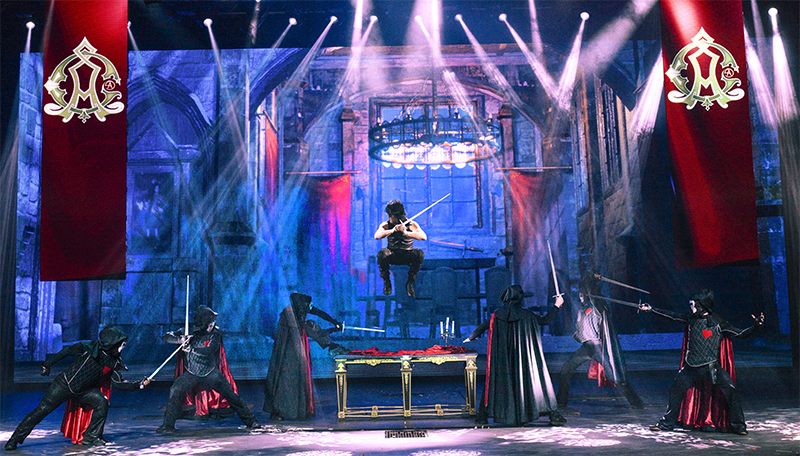
The Venue
The design for the Mindfreak show was to fully immerse the audience from the first minute they walk into the lobby of the theater. Various artifacts from Angel’s career, including his custom motorcycles and images of past illusions, are on display. A display of art in picture frames adorns one wall, based around a portrait of Angel’s Xristos character that Paul Stanley from KISS painted. As the viewer looks at the various paintings, some come to life, speaking to the audience or showing other imagery. On another wall is a video display that interacts — with a life-sized Criss Angel levitating up and down.
From the moment audience members enter the theater lobby, they engage with customized 3D content projected from two larger-than-life HYPERVSN walls; amazing holograms that come to life. These walls take advantage of HYPERVSN’s proprietary 3D holographic technology to offer the audience a true immersive experience. One of these is the largest permanent installation HYPERVSN has done to date.
Upon entering the theater, I am immersed in a world that is surrounded with media. Audience interaction and social media play a big part in Criss’ show. He also prides himself for being among the first performers to realize the value of social media as well as incorporate it in his productions. Guests are invited to take pictures in the straitjacket the magician will work himself out of later while suspended upside down over the audience. People post texts to Angel that, in turn, get posted on video fingers that run the length of the room. The artist himself will often respond to texts (or make a cameo appearance) as he monitors the crowd backstage.
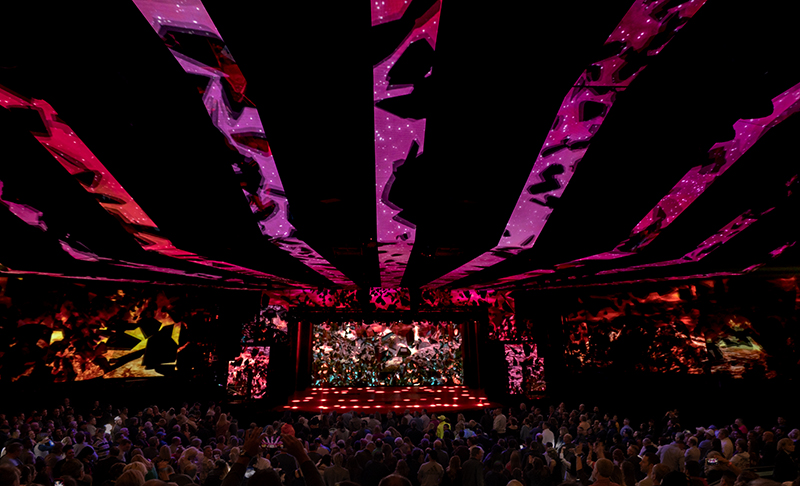
The Stage
With all of the various illusions, every piece of equipment has to be placed in the precise spot for the full effect to happen. This required a fully automated stage that included new winch systems.
Angel says, “We’ve got an enormous number of winches and chain motors in this show, performing flawlessly to my specs.” This includes all the Prodigy line sets installed as well as individual hoists. LED panels, scrims, props — as well as performers — are constantly in motion for this show. He has millions of dollars invested in automation alone for this one show.
The stage itself has a beautiful curved front edge made of grill deck. Objects are moved on and off stage with state-of-the-art automation as well as manually. ETC has been a key partner of Criss’ and provided the winch systems designed for the show.
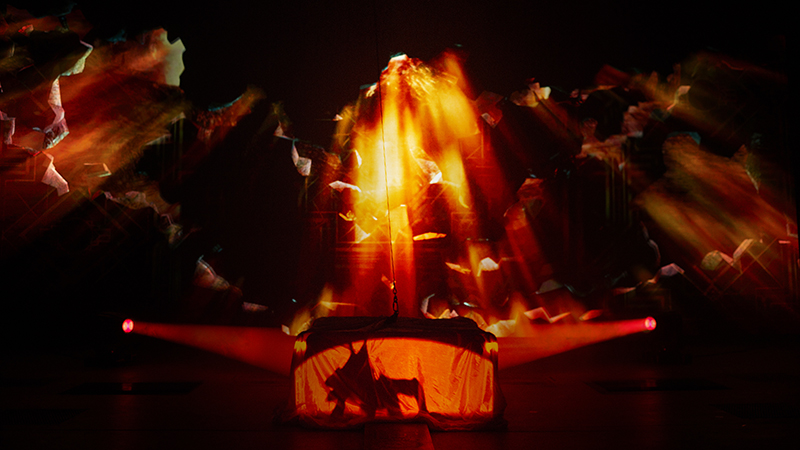
The Video
The Criss Angel Theater is immersed in video, evident from the moment one walks into the lobby. The theater itself is covered from the rear of the stage to the ceiling and sides of the structure with either LED walls, LED fingers, or projection surfaces — most of which are made by Lighthouse. Angel expands on this, “To give you an idea of how intensely the media plays into this show, we have over 4,000 cues. I’ve employed 30 editors — full-blown 3D animators — to design the video. They work around the clock, 24 hours a day, in three shifts. Believe it or not, the show is open, and we’re still working on content daily.”
There are enormous LED fingers that run the length of the ceiling from the stage to the back. Each are 100 feet long by one meter wide. These are utilized at select times to immerse the entire room in video, as well as the additional 15 various-sized displays that make up the theater’s proscenium opening. It took some doing to get the video installed in the house without eliminating any sight lines. The people from Xtreme Structures Fabrication worked hand-in-hand with Criss and his team, making sure this happened by building some custom-designed truss pieces that enabled the production to pull the video elements right up to the ceiling. Upstage is a 60-by-23-foot (WxH) LED wall, and midstage has a 20-by-30-foot (HxW) wall. Both fly in and throughout the show to aid in the 3D immersive looks with the projection.
Wherever there aren’t LED panels on display, one is certain to find a projection surface. In use inside the theater are numerous 4K+ Panasonic laser projectors. The side walls of the theater are not perfectly straight, with extruding parts featured along the 20-by-80-foot (HxW) area. This lends itself to some clever mapping, starting with the walk-in look. The imagery certainly comes alive during the performance; kudos to the subway trains running from the stage out into the house! The side walls require several 30k lumen projectors to cover each.
These projectors are all made to display the 4K content. More of them are mounted in the house and play on a midstage scrims and projection screen that fly in at select moments. At one point, Angel performs between the upstage video wall and the projected scrim downstage of it. A wave of his hand may emit a swarm of birds flying across the scrim for a split second. A sword hit may throw sparks. I am unsure of how any of this is accomplished. I realize the video does it, but…it’s magic.
All of the custom footage was shot, created, and edited in Criss’ studios and is played back through Green Hippo’s servers. The lobby is driven by two servers that feed all the TVs that are built into the columns, the “talking portraits” on the photo collage wall, the projectors that cover the floor in front of the theatre doors, and the projectors in the hallways — among many other custom attractions in the lobby. The whole production was operating at over half a billion pixels at last count.
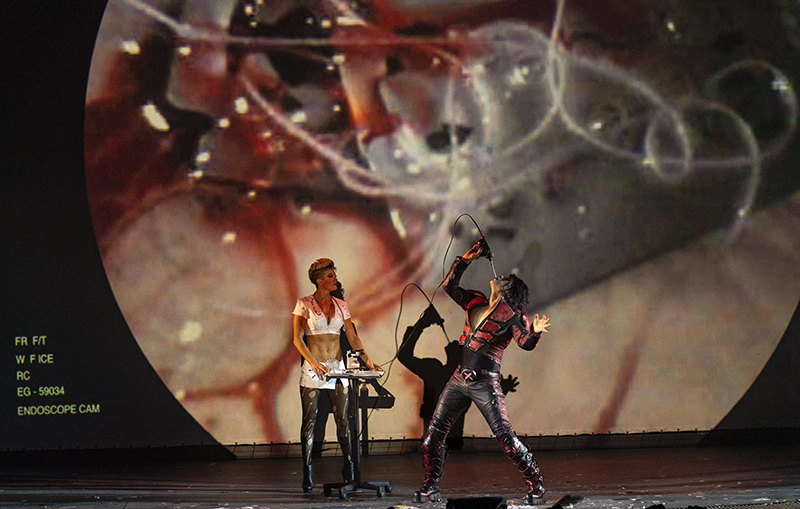
The FX
In a show where illusions are the true star, many effects play a big role in Angel’s illusions. He designs many of his own fire effects, some of which have never been seen before, for specific parts of his act. He’s keen on incorporating whatever the latest in technology available that suits his needs. “We have more fire effects than any other show,” says Angel. The lasers in the show were all installed and programmed by Image Engineering.
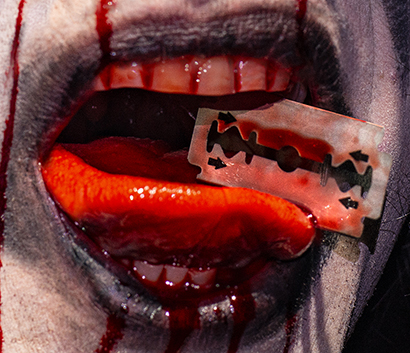
Lighting
The majority of the fixtures used at the prior show moved to Planet Hollywood, as the artist owns his own lighting. “At the moment, Criss is still adding to the act, and Josh Selander (the LD) is still ordering gear as he and Criss determine,” states Blue Planet’s Gormley. Unsure of an actual fixture count, “I can tell you that we have many 96-way 2k dimmer racks from ETC and they are full of dimmers or relay circuits. I would guesstimate that there are well over 1,000 ETC fixtures in play in this show. I’d say half of the conventionals are now LED.” The EOS Ti console that runs the show had originally been maxed out at 24,000 DMX outputs, but they were able to add an additional 8,000 outputs — to fully expand the system to 32,000 outputs.
Selander came into play as the show’s lighting designer during the last 30 months of the run at the Luxor. He works directly for Criss and they determine how to cue all the illusions. Josh programs the show as well as designs it. His full-time job is as a college professor teaching Lighting Technology at The University of North Carolina School of the Arts. Brian Rush serves as the lighting console operator for the show. “It was great that he already knew how the old show ran, so he slid right into position here easily,” says Selander.
When it came time to design a new rig, he sat down with Angel to figure out what he wanted to do and what lights would suit the show’s needs best. He explains, “I was brought in to redesign the old show at the Luxor a few years ago. At that time Criss wanted more flare, more effects. Then I relit the Mindfreak Live! tour as well.” A couple months out of the year Criss takes his show on the road and the techs at the theater can deal with all maintenance of the gear. “He also does a second touring show — called RAW — where we don’t travel with a lighting system and utilize equipment that is available in the venues that have been booked. It was during the last one of these that Criss and I started designing the new show and what we would need for his illusions.”
He adds, “A few years ago Criss wanted to lean a little more towards EDM lighting instead of the show that had featured more traditional moving lights. We did that and then moved all that gear over here and incorporated it into this show. This time around, he wanted to incorporate more rock ‘n’ roll lighting but maintain the EDM moments. In the end, we really liked what we saw available from High End Systems this year and we went that route.”
“When lighting illusions, it’s imperative that all my fixtures be the same color temperature. Once one starts getting old and losing its brightness and color, you have to change it out. But once that’s done, it may be way brighter and whiter than the other fixtures of the same type used in the illusion. The best solution was to go all LED, and High End made it simple. Since ETC and High End are a part of the same company it made bundling these two sets of products easier when it came time to make a deal.”
Hundreds more High End moving lights were added to this new production. When choosing fixtures, Selander claims, “I was adamant about having framing shutters in these fixtures, but I didn’t want a small lens profile. I needed a big fat beam with shutters that could really cut through all the other fixtures.” The SolaHyBeam 2000 fit the bill perfectly and many of these were added over the stage.
While looking for the best rock and roll/EDM moving lights, Josh and Criss found they liked the Hex and Quad fixtures as well. “While these are indeed LED lights that can be used in pixelated ways, what got me going was the fanned beams of light coming out of the 60-watt individual LEDs.” Indeed, the opening of the show with multiple Quads going off is great. During another time in the show most of the other lights are blacked out while the Hex fixtures work.
“Prior to loading in, Criss worried that all the action was on stage and the crowd wasn’t going to be immersed in the experience. That meant a second big order to High End as we filled the spaces between the LED fingers with trusses and SolaHyBeam 1000 models. They were a nice compliment to the rest of the rig,” adds the LD.
Criss seems to never be done finalizing his show. Whenever changes are made and some tweaks are needed, Selander will fix the timecode on the show file and add cues if necessary, then email it back to the board op to load into. “Safety is a huge concern with everything on this show. Everything moves fast. With heavy set pieces, automation in play, surrounded by pyro, nonstop practice is important. We run cues constantly while they practice, touching it up. This happens daily.”

In Conclusion
Criss Angel is a perfectionist and while his show is open to the public, he’s always dialing it in. “Within a year there will be totally new acts incorporated into this show. I imagine more ideas than I can ever expand on. By the way, the ending of the show will be updated by this summer. This show is a living organism and is constantly evolving and transforming. Perfection is impossible,” says Criss.


